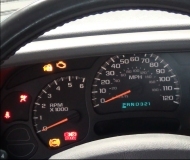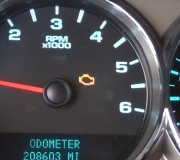Hi and thanks for using 2CarPros.
Since you replaced the pump, I would suggest checking to make sure fuel pressure is within the manufacturer's specs. Also, if the fuel filter wasn't replaced, consider doing it.
https://www.2carpros.com/articles/how-to-check-fuel-system-pressure-and-regulator
https://www.2carpros.com/articles/how-to-change-a-fuel-filter
____________________________
Here are directions specific to checking pressure on your vehicle. The directions include pressure specifications and diagnostic aids.
COMPONENT TESTS AND GENERAL DIAGNOSTICS
FUEL DELIVERY SYSTEM
Fuel Pressure Test
1. PREPARING
1. Open the service cover under the floor carpet.
2. RELEASE THE INTERNAL PRESSURE
1. Disconnect the fuel pump connector.
2. Start the engine and wait until fuel in fuel line is exhausted.
3. After the engine stalls, turn the ignition switch to OFF position and disconnect the negative (-) terminal from the battery.
Note: Be sure to reduce the fuel pressure before disconnecting the fuel feed hose, otherwise fuel will spill out
Fuel Pressure Special Service Tool
See picture 1
3. INSTALL THE SPECIAL SERVICE TOOL (SST) FOR MEASURING THE FUEL PRESSURE
1. Disconnect the fuel feed hose from the delivery pipe.
Caution: Cover the hose connection with a shop towel to prevent splashing of fuel caused by residual pressure in the fuel line.
2. Install the Fuel Pressure Gage Adapter (09353-38000) between the delivery pipe and the fuel feed hose.
3. Connect the Fuel Pressure Gage Connector (09353-24000) to the Fuel Pressure Gage Adapter (09353-38000).
4. Connect the Fuel Pressure Gage and Hose (09353 41 00) to Fuel Pressure Gage Connector (09353-24000).
5. Connect the fuel feed hose to the Fuel Pressure Gage Adapter (09353-38000).
4. INSPECT FUEL LEAKAGE ON CONNECTION
1. Connect the battery negative (-) terminal.
2. Apply battery voltage to the fuel pump terminal and activate the fuel pump. With fuel pressure applied, check that there is no fuel leakage from the fuel pressure gauge or connection part.
5. FUEL PRESSURE TEST
1. Disconnect the negative (-) terminal from the battery.
2. Connect the fuel pump connector.
3. Connect the battery negative (-) terminal.
4. Start the engine and measure the fuel pressure at idle.
Standard Value: 343 Kpa (3.5 kgf/cm cm, 49.8 psi)
Incorrect Pressure
See picture 2
If the measured fuel pressure differs from the standard value, perform the necessary repairs using the table below.
Pressure Drops
See picture
5. Stop the engine and check for a change in the fuel pressure gauge reading.
After engine stops, the gage reading should hold for about 5 minutes
Observing the declination of the fuel pressure when the gage reading drops and perform the necessary repairs using the table below.
6. RELEASE THE INTERNAL PRESSURE
1. Disconnect the fuel pump connector.
2. Start the engine and wait until fuel in fuel line is exhausted.
3. After the engine stalls, turn the ignition switch to OFF position and disconnect the negative (-) terminal from the battery.
Note: Be sure to reduce the fuel pressure before disconnecting the fuel feed hose, otherwise fuel will spill out.
7. REMOVE THE SPECIAL SERVICE TOOL (SST) AND CONNECT THE FUEL LINE
1. Disconnect the Fuel Pressure Gage and Hose (09353-24100) from the Fuel Pressure Gage Connector (09353-24000).
2. Disconnect the Fuel Pressure Gage Connector (09353-24000) from the Fuel Pressure Gage Adapter (09353-38000).
3. Disconnect the fuel feed hose from the Fuel Pressure Gage Adapter (09353-38000).
4. Disconnect the Fuel Pressure Gage Adapter (09353-38000) from the delivery pipe.
Caution: Cover the hose connection with a shop towel to prevent splashing of fuel caused by residual pressure in the fuel line.
5. Connect the fuel feed hose to the delivery pipe.
8. INSPECT FUEL LEAKAGE ON CONNECTION
1. Connect the battery negative (-) terminal.
2. Apply battery voltage to the fuel pump terminal and activate the fuel pump. With fuel pressure applied, check that there is no fuel leakage from the fuel pressure gauge or connection part.
3. If the vehicle is normal, connect the fuel pump connector.
____________________________________________________
If pressure is within the manufacturer's specs, then I suspect a bad crankshaft position sensor. Take a look through this link:
https://www.2carpros.com/articles/symptoms-of-a-bad-crankshaft-sensor
__________________________________________________
Here is a link that shows in general how this sensor is replaced:
https://www.2carpros.com/articles/crankshaft-angle-sensor-replacement
Picture 4 shows the crankshaft position sensor's location. You need to remove the timing belt cover to replace it.
Let me know if this helps.
Take care,
Joe
Images (Click to make bigger)
Sunday, January 13th, 2019 AT 11:20 AM








